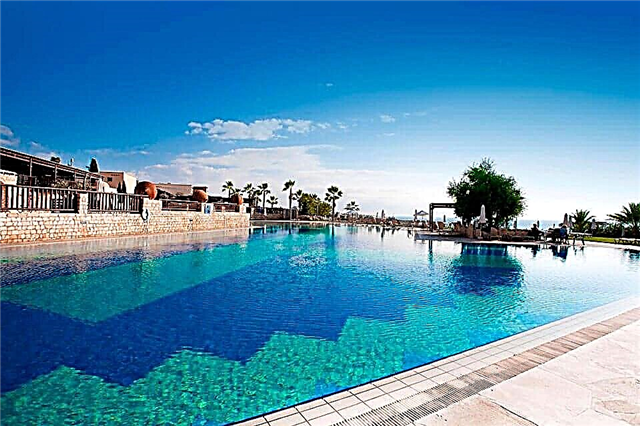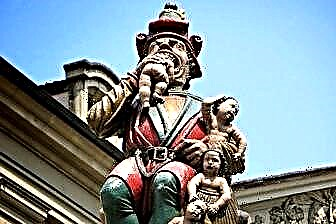Small cozy Bern does not at all look like the capital in the usual sense of the word. Its lush green streets, red-tiled houses, church spiers would be more appropriate in a prosperous province, where people have lived a measured life for centuries, and are not in the thick of things. Nevertheless, Bern is the administrative center of Switzerland, where many states send their ambassadors.
A wide field of activity opens up for tourists in the city. After exploring the many architectural sights in Bern's historic quarters, you can tackle the local museums or enjoy the majestic views of the Alpine peaks that rise against the piercing blue sky.

The best hotels and hotels at affordable prices.
from 500 rubles / day
What to see and where to go in Bern?
The most interesting and beautiful places for walking. Photos and a short description.
Old city
The historical part of Bern, located in a hilly bend of the Are river. Since 1983, it has been included in the UNESCO World Heritage List. Most of the city's attractions are located in the old quarters. The first settlements in this area appeared at the end of the 12th century, when the founder of Bern, Duke Berthold V Zeringen, came here. Today, former residential buildings in this part of the city are home to restaurants, hotels, clubs and offices.

Bernese fountains
Bern is famous for its numerous fountains-wells, many of which were created in the XIII-XVI centuries. Bernese fountains guard statues of fairy-tale creatures made by the sculptor G. Ging. The most frightening statue is the Child Eater. This is an evil giant with a bag stuffed with the bodies of children (he eats one of them). Apparently, the sculpture was created to help parents raise their naughty offspring.

Federal palace
The palace complex was built in 1894-1902. designed by G. Auer in the neo-Renaissance style. The building is used as a meeting place for the Swiss government. The palace is 64 meters high. Its roof is crowned with a huge dome, on the inside of which the coat of arms of Switzerland and its 22 cantons (as of the beginning of the 20th century) are lined with mosaics. The building is open to the public. From special galleries you can watch the parliamentary session.

Cytglogg
The astronomical clock tower, supposedly built in the 13th century as a defensive fortification. At the beginning of the 15th century, the building burned down, after which it was rebuilt from local sandstone. The building acquired its modern look in the 16th century. The old clock tower of the Zytglogge is over 500 years old. All these centuries, the townspeople used them to determine the exact time.

Prison tower
The tower was built in the middle of the 17th century on the site of the city gate. Until 1897, it was used to keep prisoners (hence the name), then the city archive was placed on the premises. At the same time, an observation post was located in the tower, from where the caretaker could notice the starting fire in time. Now this point has been converted into an observation deck for tourists.

Town hall
Bern Town Hall is an example of mixed architecture. In its appearance, Romanesque features, as well as elements of early and late Gothic are guessed. The town hall was built at the beginning of the 15th century for the needs of the city council. Subsequently, the building was rebuilt several times, while its architectural appearance changed somewhat. Today, in addition to the city council, the church parliament of the canton of Bern sits here.

Berne cathedral
Cathedral of the Protestant Church of Bern, located in the historic part of the city. The construction of the temple lasted for several centuries - from the 14th to the end of the 19th centuries. The dominant architectural style of the building is late Gothic. The interior of the cathedral is quite simple and laconic. All unnecessary, according to church reformers, decorations were removed from here back in the distant 16th century, so that believers could focus only on communion with God.

Church of Nidegkirche
A small church with a high spire, built in the middle of the 14th century. In the difficult years of the Reformation, the temple was almost abandoned; services were resumed here only in 1566. In the middle of the 20th century, the building was reconstructed under the direction of the architect M. Perinkaioli. As a result, new bronze reliefs were added to the façade. In 1968, a monument in honor of Berthold V Zeringen was erected in the courtyard of the temple.

Church of the Holy Spirit
A modest and graceful 18th century Baroque church, considered one of the most important Protestant parishes in Switzerland. Like other local churches, its interior is not luxurious, but still the walls are decorated with rich stucco, and the hall contains a circular gallery of massive columns. The Church of the Holy Spirit is one of the most spacious in the country. It can accommodate up to 2 thousand people.

Church of St. Peter and Paul
The first Catholic church built after the victory of the Reformation in Switzerland. The church was built in the period from 1858 to 1864. The facade is made in a mixed architectural style. On it you can see the features of the Gothic and late Romanesque style. The interiors were painted in the Art Nouveau style relatively recently - in 1998. Despite belonging to the Catholic diocese, the Church of St. Peter and Paul is relatively independent from the Vatican.

Paul Klee Center
The museum, the collection of which is made up of the works of P. Klee, an avant-garde graphic artist and art critic. The idea to create an exhibition appeared after the master's descendants donated more than 700 of his works to the city. The building of the museum was erected at the expense of the Müller family according to the project of the architect R. Piano. The opening took place in 2005. The collection is located in the underground part of the building, since Klee's paintings are sensitive to light.

Albert Einstein House Museum
A. Einstein lived in the house at 49 Kramgasse from 1903 to 1905. while working at the local patent office. It was here that the great scientist wrote the first articles that covered the fundamental postulates of the theory of relativity. In Einstein's former apartment, the original furnishings of the early 20th century have been recreated, photographs of the scientist and his family hang on the walls, scientific works and documents are stored on the shelves.

Bern History Museum
The museum is located on Helvetiaplatz square. The building was built at the end of the 19th century. From the outside, it resembles a real castle. The museum exposition is divided into four large sections, where thousands of items are exhibited. In total, the funds contain more than 250 thousand exhibits. Here you can see knightly armor, ancient coins, decorative elements of temples, church utensils and much more.

Art Museum
The collection contains a large number of paintings by Swiss, French, Italian and Spanish masters of the XIV-XX centuries. The avant-garde exposition, which was donated to the museum in 2014 on behalf of a private art connoisseur, deserves special mention. It includes works by S. Dali, P. Cezanne, A. Matisse, A. Modigliani, V. Kandinsky and other artists. In addition to paintings, the museum contains 3,000 sculptures and 48,000 engravings.

Natural History Museum
Natural Science Exposition, which was founded in 1832. The museum staff works closely with the University of Bern. The collection consists of stuffed animals, skeletons, minerals, huge crystals. There are even meteorite shards and gold bars. Many halls have interactive installations that imitate the smells and sounds of the wild.The Berne Museum has one of the most comprehensive natural science exhibitions in Switzerland.

Museum of Communication
The exhibits of the museum tell visitors the history of the development of various means of communication. Old telephones, telegraphs, radios, televisions, computers and other devices are exhibited here. An impressive part of the exposition is devoted to digital technologies. The museum has a specialized sanatorium, where people with computer addiction are treated.

"Bear pit"
"Bear Pit" is a small bear park with an adjoining moat; they are a branch of the Delhölzli City Zoo. The bear is considered the heraldic symbol of Bern; this animal is treated with great reverence here. The first pit appeared in the city in the 15th century, since then it has repeatedly moved from place to place. The park is a popular tourist attraction.

Botanical Garden
The botanical garden is located at the University of Bern. It contains a collection of plants from the tropics, deserts, steppes, forests and alpine meadows. The garden was created in 1862. In some greenhouses with especially valuable plants, the access of visitors with children may be limited, as the administration is concerned about the safety of delicate flora that are sensitive to the slightest impact.

Rose garden
A romantic landscape park where about 220 varieties of roses and about 200 types of irises grow and smell. The garden is strewn with flowers in all shades of red, yellow and white. From here, a picturesque view of the historic part of Bern opens up, as the rose garden is located on a hill. The garden appeared in the 20th century on the site of the former city cemetery. This is a great place for walking, relaxing and philosophical reflection.

Park Gurten
Mount Gurten is located a few kilometers from Bern. Its height is about 864 meters. An amusement park of the same name is organized on the elephants of the mountain. In winter they go skiing and sledging, and in summer they do bicycles. The park has a hotel, restaurants and conference facilities. Every year the musical festival "Gurtenfestival" is held here, which attracts participants from all over Europe.












